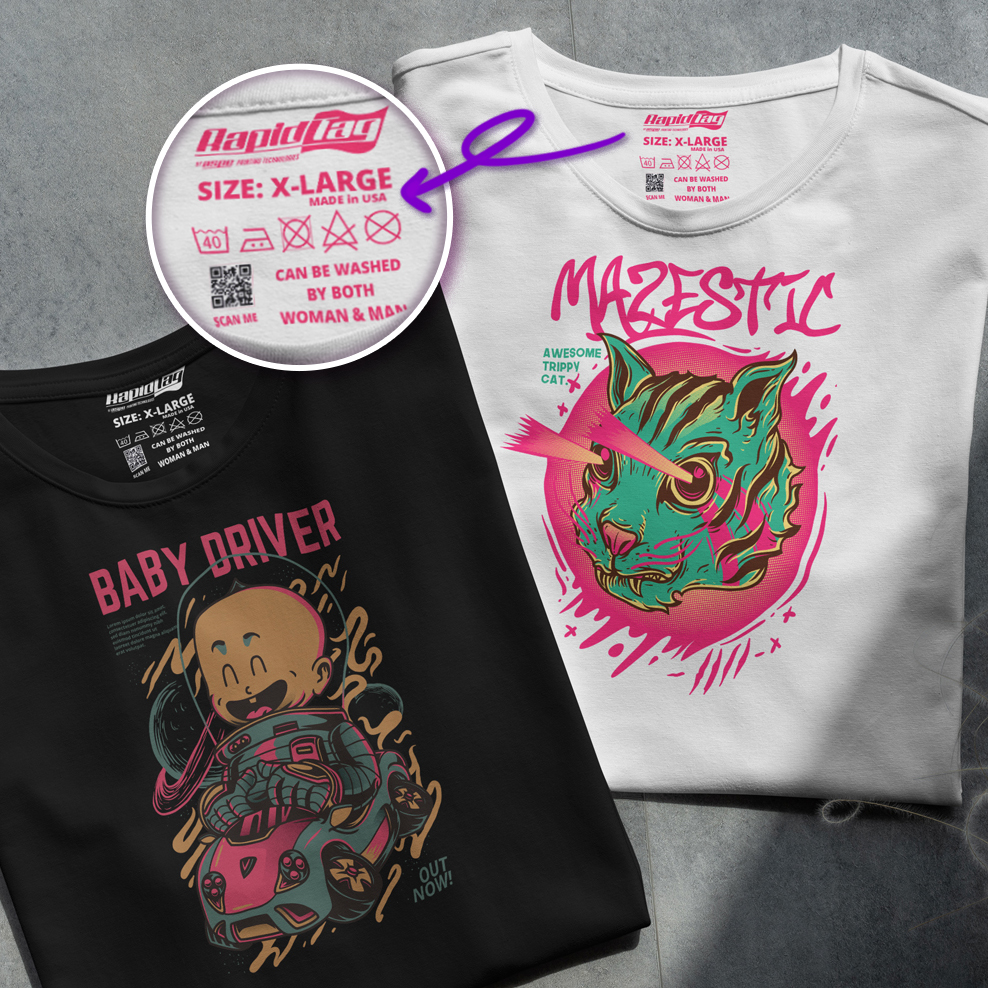
The Essential Guide to Tagless Labels on Garments
Tagless labels are all the rage in the garment industry these days. Tags and labels on shirts, pants, and other items of clothing may be considered the norm, but in recent years, more companies are opting to print tags directly onto the garments themselves for a variety of reasons.
We’ve put together this blog to explain the benefits and history of tagless label printing, giving you all the information you need for your own garment production.
Why Do Clothes Have Tags?
Traditional clothing labels became commonplace in garments in 1960, originally sewn into clothes as a result of the Textile Fiber Products Identification Act. This law made it a requirement for clothing manufacturers to list the exact materials used in garments by weight. 11 years later the Federal Trade Commission added to the practice by releasing the Care Labeling Rule, which set the standard for care and washing information to be included on labels.
Over the years, the approach to underwear, pants, and shirt tags has developed, with icons being introduced in the 1990s as a way to communicate more information with fewer words. So while it may seem like labels exist purely to scratch and irritate us when wearing clothes, they actually have a worthwhile purpose.
When & Why Were Tagless Labels Introduced?
Tagless labels were first introduced in 2002 by menswear titans Hanes, marketed with endorsement from none other than basketball legend Michael Jordan. The promotion of their tagless undershirts, boxers, and briefs was focused on the idea that tags were an unnecessary annoyance and that clothes would be more comfortable without them. Hanes discovered through market research that the irritation of tags was the biggest issue facing their target audience, which just goes to show how ready the market was for a change.
Tagless labels have been embraced by consumers with open arms, with the increased comfort of printed tags in clothing considered a massive selling point. After Hanes brought tagless labels into the mainstream, many other brands followed suit.
The Benefits of Tagless Labels for Manufacturers
Along with offering value to customers in the form of comfort, tagless labels also offer benefits to the manufacturers themselves. Without the need to sew tags in, the production of clothes can be quicker, cheaper, and more efficient in general, while also increasing the potential for clever branding and design versatility.
Cost
When it comes to the cost of traditional labeling, manufacturers can expect to pay anywhere between 4 and 8 cents at a time, not to mention the costs associated with sewing. On the other hand, tagless label printing generally comes at a fraction of this cost, with the cost per print generally being around $0.002-0.003.
Time
Along with saving money in manufacturing, tagless label printing is also a much quicker way to get the necessary information onto garments. Sewing in labels, whether done by hand or machine, adds a significant amount of time to the production process, but pad, heat transfer, and screen printing can be completed much quicker.
Customization
While tagless labeling can save money and time in the production process, it’s also handy for infusing the labels with more personality. A traditional label has to be small to avoid being too uncomfortable, meaning there’s limited space for additional branding or designs. With tagless labels, you can be more creative with fonts, graphics, and logos without reducing comfort.
Tagless Label Printing Technology
There are a number of different options when it comes to the technology used to print on tagless labels, each with its own pros and cons.
Heat Transfer Printing
Heat transfer printing is popular with smaller brands, being an easy and affordable way to transfer images to clothing. It essentially works by images on paper or vinyl being pressed onto fabric with heat, leaving behind designs.
Pros:
- Very affordable to set up and cost-effective, especially for smaller orders
- Capacity to print complex, high-quality images
- Eco-friendly and clean
Cons:
- Images and labels feel stiff once printed on
- Designs don’t last after too many washes
- Colors aren’t particularly bright – not ideal on darker items of clothing
Pad Printing
Pad printing is essentially like stamping designs directly onto clothes. The ink is applied to a silicone pad, which then picks up the design from an ink plate, and then the t-shirt tag is pressed straight onto the fabric.
Pros:
- Cheap in terms of supplies
- Can be largely energy-efficient
- Fast printing process
Cons:
- Takes added time for ink to dry and cure
- Colors have to be applied one by one in different layers
- Expensive to set up
Screen Printing
Screen printing dates back over a thousand years ago, being a method that’s been adapted for the times over the generations. Ink is passed through a stencil, one color at a time, directly onto the garments.
Pros:
- Designs last longer than with other methods
- The printed labels or designs feel softer and more natural on clothing
- Cost-effective for larger production quantities
- Vibrant in color, even on darker fabrics
Cons:
- Larger initial investment
- Best for simpler designs
- Not the fastest method
Tagless Labels: Final Thoughts
When it comes to tagless clothing labels, we think they’re the way forward! Not only do they offer your customer added comfort, which can be marketed as a premium feature, but they also reduce production costs, save time, and offer you more versatility.
In keeping with the theme of added comfort, we feel that screen printing is the best choice for tagless labels, making clothes feel their softest and most natural, while also offering a cost-effective method for larger quantities of clothes.
Visit our site today to browse for your very own Rapid Tag screen printing machine, so you can take your clothing business to the next level with tagless labels.
tagless labels
